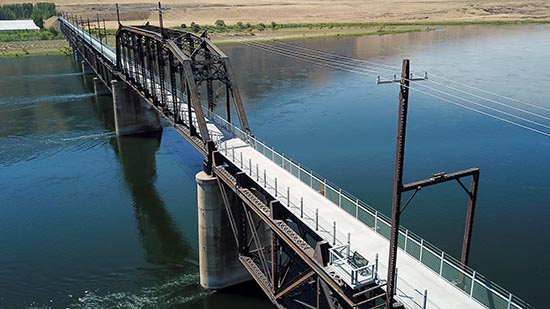|
Subscribe / Renew |
|
|
Contact Us |
|
| ► Subscribe to our Free Weekly Newsletter | |
| home | Welcome, sign in or click here to subscribe. | login |
Construction
| |
 |
February 6, 2023
Best In State: Gold Award
Social, Economic And Sustainable Design

Exeltech Consulting
Project: Beverly Bridge rehabilitation
Client: Washington State Parks and Recreation Commission
Once a missing link to non-motorized trail travel across Washington, the historic Beverly Bridge now provides hikers, cyclists, equestrians, and residents a safer route between the eastern and western sections of the 284-mile-long Palouse to Cascades State Park Trail across the Columbia River. Originally built in 1909, this bridge is now the longest rail-to-trail bridge in Washington and the only non-motorized crossing of the Columbia River.
Exeltech Consulting designed the rehabilitation of the 3,000-foot-long former railroad bridge for the Washington State Parks and Recreation Commission. The bridge was added to the National Register of Historic Places in 1982 and has been closed since the 1980s. In 2014, a wildfire destroyed the bridge deck.
The Exeltech team led the Beverly Bridge rehabilitation project design, engineering, environmental documentation, and permitting — and supported State Parks’ community outreach activities. Several priorities guided all decisions, including preserving the aesthetics of the structure and mitigating impacts on sensitive cultural and natural resources.
The bridge is in the traditional home of the Wanapum and the Sinkayuse tribes, and is a historic route for explorers, fur traders, and homesteaders. Numerous pre-contact archaeological sites, historic buildings and structures were documented within and near the project area.
Considering the sensitive site, the team applied accelerated bridge construction principles to design and permit a cost-effective rehabilitation that preserved the grand appearance of the historic structure and the stunning views with minimal site disturbance. The approach also helped to expedite complex agency coordination and approvals.
Exeltech engineers designed nine sizes of deck slabs that would work for all spans, and included cutting a small notch in 22 slabs in the location of the knee braces on the existing span. This design allowed for the placement of new decking/walkway panels with no loss of structural integrity or modifications to the underlying floor beams or plate girders while maintaining the appearance of the historic bridge, solving a complex design challenge.
Transporting prefabricated deck slabs and railing for rapid erection and construction with simplified on-site connection details was both timely and cost-effective.
The bridge design also includes power lines, restoring reliable electrical service to remote areas along the west bank of the Columbia River that are difficult to access. This power redundancy supports economic development for communities within Kittitas and Grant counties. As an added benefit, community outreach efforts indicated that the bridge would also serve as a pedestrian commuter pathway for orchard employees living east of the Columbia River to cross daily.
Other Stories:
- National Finalist: Platinum Award
Transportation - Best In State: Gold Award
Future Value To The Engineering Profession - Best In State: Gold Award
Complexity - Best In State: Gold Award
Exceeding Client/Owner Expectations - Best In State: Gold Award
Unique Or Innovative Application Of New Or Existing Techniques - National Finalist: Gold Award
Surveying/Mapping Technology - National Finalist: Gold Award
Special Projects - National Finalist: Gold Award
Structural Systems - National Finalist: Gold Award
Structural Systems - Diversity And Inclusion Award: Mid-Sized Firm
- Diversity And Inclusion Award: Large Firm
- Engineer of the Year
- National Finalist: Gold Award
Transportation


